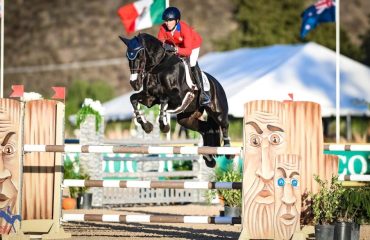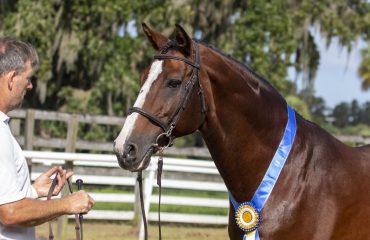
Charlotte Bredahl and Leo
Photo by Kate Burke
Charlotte Bredahl was a member of the 1992 bronze medal U.S. Olympic dressage team in Barcelona riding Monsieur. In 1997, she was part of the silver–winning team at the North American Championship on Lugano. She trained both horses from the start. Charlotte is a USEF (S) judge and FEI 4* judge who has judged all over the world. Three years ago, she was appointed USEF Assistant Youth Coach and now dedicates most of her time to coaching. She recently purchased a home in Wellington, Florida, where she plans to spend winters. Do you have a question you want Charlotte to answer? Send questions to editor@sidelinesnews.com.
When do you introduce counter canter?
When the horse can stay in decent balance on both straight lines and on 15-meter circles and work in a steady connection. I will explain my favorite exercise to introduce counter canter to both horses and riders. Let’s say you are on left-lead canter and you go from F towards the first quarter line. You should reach it between B and X. At that point, you do a 15-meter circle left. When you finish the circle, you continue on a straight line to M. After you have done that a few times, your horse (and you) will start to anticipate the circle coming up and will come into a better balance. When that’s working really well, it’s time to leave out the circle and you end up doing counter canter on a very shallow loop. When the counter canter to quarter line is working well, it’s time do the same exercise to the center line. This time you’ll go directly from F to X and then do a 10-meter circle. After the circle, you go straight to M. When that becomes easy, leave out the circle and you should have a nice, balanced counter canter. Keep in mind most horses will have better balance in one direction so you have to adjust the exercise accordingly. Horses always tend to anticipate what’s coming up next and we want him to anticipate the circle. Without doing the circles first, most likely he will anticipate either a flying change or he’ll lose his balance.
What’s the next step after the horse is doing well with bending lines and transitions between gaits?
 Once the horse is moving nicely forward from the inside leg and beginning to understand the aids for moving sideways, it’s time to work more on straight lines and on leg-yielding. I usually start leg-yielding by going down the quarter line and then leg yield gradually to the wall. I start out with nice flexion to the inside, referring to the poll, but no neck bend. Then I press with inside leg and push the horse towards the wall. You have to pay very close attention to the alignment of the horse, so he stays almost straight and doesn’t pop the shoulder to the outside. He will tell you where your inside leg should be: If the haunches are leading, you need your leg closer to the girth and if haunches are trailing, further back. Keep your outside rein firm enough to control the shoulder. Make sure to keep the forward flow.
Once the horse is moving nicely forward from the inside leg and beginning to understand the aids for moving sideways, it’s time to work more on straight lines and on leg-yielding. I usually start leg-yielding by going down the quarter line and then leg yield gradually to the wall. I start out with nice flexion to the inside, referring to the poll, but no neck bend. Then I press with inside leg and push the horse towards the wall. You have to pay very close attention to the alignment of the horse, so he stays almost straight and doesn’t pop the shoulder to the outside. He will tell you where your inside leg should be: If the haunches are leading, you need your leg closer to the girth and if haunches are trailing, further back. Keep your outside rein firm enough to control the shoulder. Make sure to keep the forward flow.
 Once the leg yield from the quarter line is working well, you can try from the center line. Use the same process as before, but go straight several strides when you get to the quarter line to make sure you have proper alignment. At this stage of training, you are only doing this in walk and trot. Keeping a young horse straight in the canter is often not so easy. Most horses will naturally want to carry haunches a bit to the inside. The rider needs to help the horse by riding in a slight shoulder-fore in the canter. You have to have enough control of the outside rein to prevent the horse from popping the shoulder to the outside and enough inside leg to keep him from falling in. You have to keep your inside leg at the girth, because if you put your leg back, you’re asking for a flying change. In the beginning it’s better to only go straight about 20 meters at a time, before doing a circle. Most young horses have trouble staying in balance at the canter on straight lines and will need a circle to get balance back.
Once the leg yield from the quarter line is working well, you can try from the center line. Use the same process as before, but go straight several strides when you get to the quarter line to make sure you have proper alignment. At this stage of training, you are only doing this in walk and trot. Keeping a young horse straight in the canter is often not so easy. Most horses will naturally want to carry haunches a bit to the inside. The rider needs to help the horse by riding in a slight shoulder-fore in the canter. You have to have enough control of the outside rein to prevent the horse from popping the shoulder to the outside and enough inside leg to keep him from falling in. You have to keep your inside leg at the girth, because if you put your leg back, you’re asking for a flying change. In the beginning it’s better to only go straight about 20 meters at a time, before doing a circle. Most young horses have trouble staying in balance at the canter on straight lines and will need a circle to get balance back.













